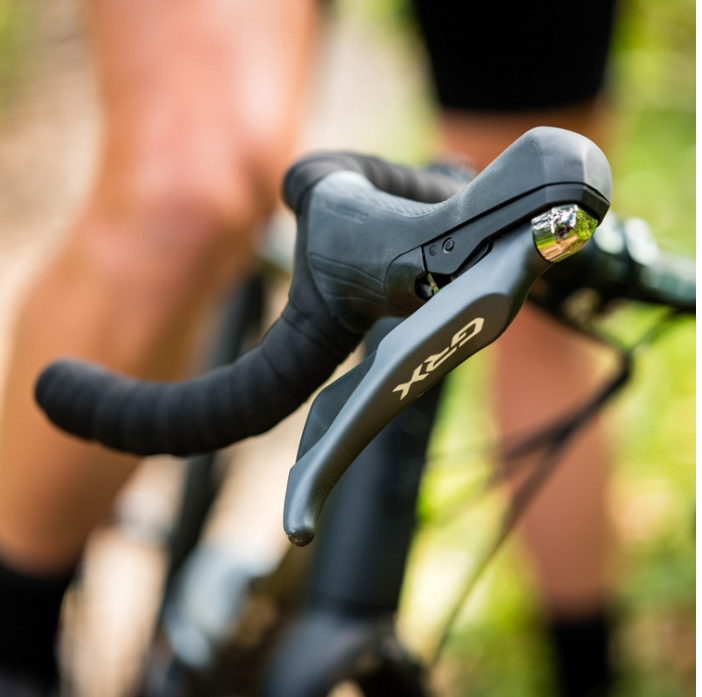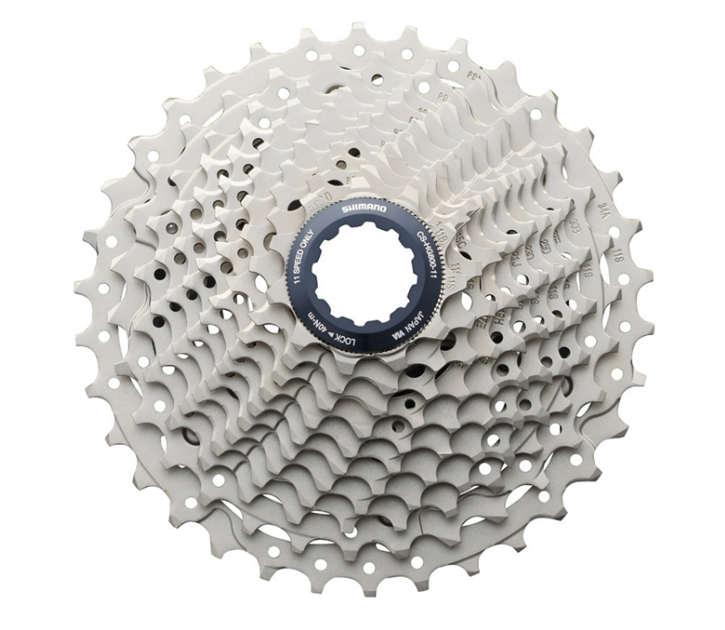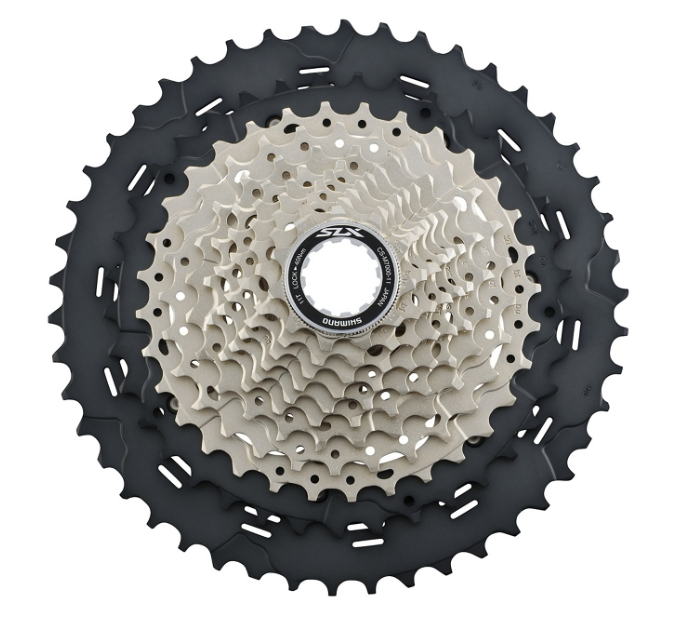
People in the cycling industry and cycling community had been clamouring for Shimano to produce a gravel-specific groupset for some time. So, when Shimano announced the launch of their GRX range it was one of the most eagerly-anticipated product launches in recent history. What is Shimano GRX? What makes it so unique? Allow us to explain.....
Sometimes you see a trail heading off across the fields and think to yourself 'I wonder where that goes?' Or you just prefer to leave the road behind and seek the solitude of forest trails and bridleways for a few fun-filled hours. Well for this and more the gravel bike was developed, a bike that's off-road capable, yet can turn its hand to road riding too.
Gravel bikes place different demands on a bike and rider. When riding over tougher terrain or in quagmire-like conditions you need a gear range to help you navigate your way through. Shimano took up the challenge and launched their gravel-specific GRX series, a groupset that has the gearing you need to maximise your gravel bikes off-road potential.
How to explain what GRX is.... It's not that simple, GRX is a range of groupsets, well kind of. You see they aren't the groupsets that we know and love, you know the ones where all of the components belong to that groupset exclusively. With GRX there is a crossover of components, this allows people to pick and choose what parts they wish to fit and guarantees inter-compatibility. So, what are the options?
RX400
The entry point to GRX is the RX400, rather than a single chainring it instead features a double chainring much like standard road groupsets. The two chainrings at the front and 10 sprockets on the cassette on the rear give you a total of 20 gears in total. This would put it on a par with Shimano's Tiagra road series groupset which also offers 20 gears in total.
Where GRX400 differs markedly is in chainring size, it is equipped with smaller chainrings than you would expect to see on a road chainset. In this case, 30 and 46T, instead of a road compact 34-50, and when this is combined with an 11-32 road range cassette it offers a very low gear range indeed.
RX600
The next step up is the RX600 which is equivalent to the 105 road series. It is available in a single chainring or double chainring configuration for 1x11 speed or 2x11 speed gearing. The levers and chainset are RX600 but the rear derailleur and front derailleur (double) are taken from the RX810 series. The double setup again comes with 36-40 chainrings and an 11/32 or 11/34 road cassette. The single chainring is a 40T and comes with an SLX (MTB) 11-42T ratio cassette.
RX810
Move up again to the RX810, again this is available in a double or single ring configuration. The RX810 benefits from slightly lighter and more advanced materials which offer a more premium finish and lighter overall weight. The double setup uses an RX810 front derailleur and RX810 rear derailleur with maximum sprocket size of 34T. The single chainring system uses an RX812 rear derailleur which is compatible with cassette sprockets of up to 42T.
RX815 Di2
Yes, Shimano even offers GRX with their market-leading electronic shifts. Like the RX810 it is available with 1 or 2 chainrings and the rear derailleur will change depending on which one you choose. Di2 is fully programmable meaning that you can change how the system behaves. You can programme it to shift all the way up and down the block by simply holding a button in, shift singly and even swap which levers operates each derailleur. The other key feature is that after every shift the derailleur self-adjusts so there is no chain rub and the chain line always remains optimal.
CHAINSET

GRX is available in a double configuration with 30/46 or 31/48 tooth chainrings, dependant upon which system you choose. It's also available in a single ring configuration which is referred to simply as one-by (1x). Which you choose is purely down to personal preference but we'll try and assist you in determining which suits your riding style/needs better.
GEAR SHIFTERS

Shimano has added some nice finishing touches to their levers which have in their own words 'gravel inspired ergonomics'. Fancy words aside this translates into some seriously stylish and comfy levers. The shifter itself offers the same impressively smooth shifts of its road and MTB siblings. The lever blade features some radical new shaping, with a distinctive scoop that fits your fingers snugly when braking or simply when resting your hands on the hoods. The levers also benefit from a new textured anti-slip material which helps to provide more purchase when the terrain gets bumpy.
These levers also connect to some of the most impressive hydraulic disc brake calipers available. Providing superior control and stopping power over any terrain and in any prevailing weather conditions.
FRONT DERAILLEUR
If you choose the 1x system then you can obviously ignore this section. The GRX front mech for the double system owes its design to the road range of derailleurs. Though the GRX derailleur is designed to accept a wider range of gears.
REAR DERAILLEUR

A GRX RX812 derailleur fitted to the Ribble CGR Ti; note the small grey lever next to the top pulley wheel. This is the on/off switch for the clutch/chain tension.
To better cope with the ever-expanding cassette sizes, Shimano has called upon their MTB expertise and applied their Shadow + design to the GRX series of rear derailleurs. Each derailleur is now equipped with a chain tension system (clutch) to prevent the chains from being unshipped over bumpy surfaces and also to help reduce chain-slap (when the chain bounces and chips the chainstay).
CASSETTE
GRX utilises 2 types of cassette, the double system will use a narrower spread road range cassette in ratios of 11/32 or 11/34. The 1x system will be equipped with an MTB style cassette with a wider ratio of 11-42 or thereabouts.
Which should i choose?
Well....this is the million-dollar question, both have their pro's and their con's;
1x Pro's
- Weight- With only 1 chainring there's no need for a front derailleur with its attendant cabling or the internals for the front gear shifter (marginal gains).
- Maintenance - There are no words for how much of a pain it is to clean the front derailleur, behind the front derailleur and the rear of the chainset.
- Gear adjustment - No front mech, no adjustment required (WIN).
- No front derailleur - With the removal of the front derailleur there's lee to go wrong mechanically. The chain cannot jam in a front derailleur that is not present nor can debris such as twigs or mud cause a chain jam.02
1x Con's (you will note these are very minor)
- Gear range - Because the cassette covers such a wide range of sprocket sizes the step up from one sprocket to the next adjacent sprocket get larger as you shift up the cassette. This is less efficient and can affect your pedalling rhythm, particularly when climbing.
- Spinning out - Directly linked to the above, because the hardest gear you can pedal is only an 11-40T or 11-42T you will absolutely 'spin-out' on descents. (There will be no tension on the cranks so your legs just spin like the clappers).
Double Pro's
- Gear range - A 46 or 48T large chainring combined with a 30 or 31T inner chainring means that a narrower spread cassette can be fitted. Therefore the increase in the number of teeth between 1 sprocket and the next are smaller. This helps has less impact on pedalling rhythm when changing gear.
Con's
- Weight - The extra weight of the chainring, front derailleur (including associated cabling) and internals of the front shifter add a small amount of weight.
- Maintenance - Having that extra chainring and derailleur in place makes it harder to clean that area of the bike.
- Chain jam - When riding through sticky off-road terrain it is possible for the chain to pick up dirt and debris which the lodge in the front derailleur and causes the chain to jam or to drop.
- Gear adjustment - Gear cables need replacing and cables stretch causing more adjustment to be required.
Summary
So what can we conclude from all of this information?
Both the double and single ring systems have their merits and let's face it there are no real downsides. When comparing the 2 we are looking for the most minuscule of differences. Both offer the extremely low gear range that you require when riding off-road and you'd be hard-pressed to be affected by this gear range when riding on tarmac either.
It boils down to this, do you feel the extra gears offered by a double system to be absolutely essential to your riding experience? Or would you prefer the simplicity of the single ring set up without the faff of having to adjust the front gear and the added ease of cleaning the 1x drivetrain?

